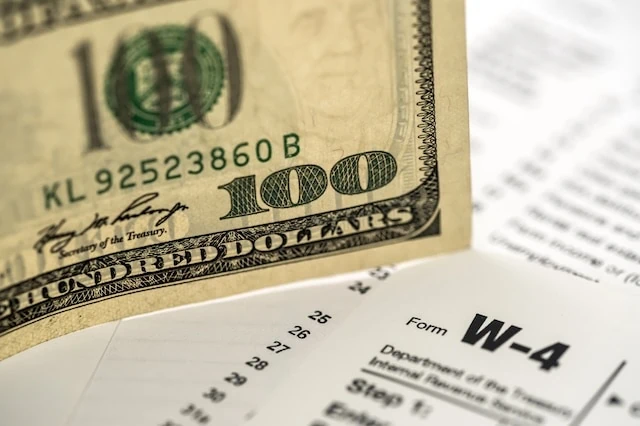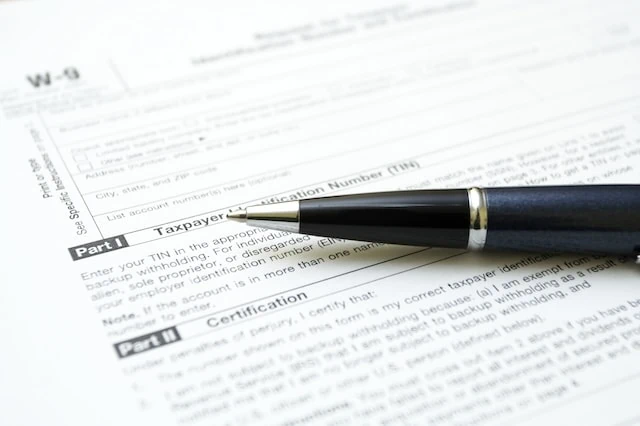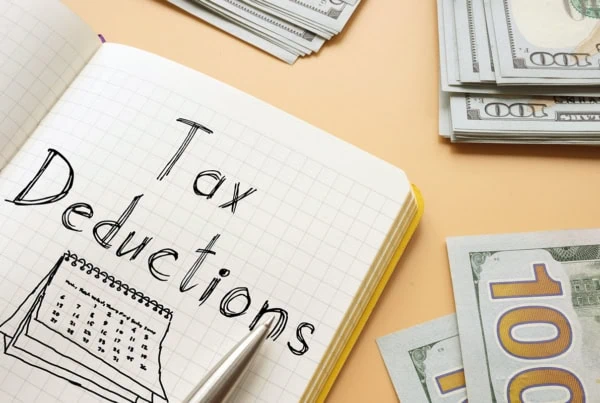The Internal Revenue Service (IRS) requires employers and employees alike to use specific tax forms to accurately record wages, benefits paid, taxes withheld, and other essential financial information needed for proper tax information reporting. Organizing all of this related, yet separate, information requires the use of different tax documents, such as Forms W-2, W-4, and W-9.
These IRS forms are some of the most important documents employers and employees must use and understand in order to comply with federal tax laws. While each form is distinct, they all share the common purpose of ensuring that federal taxes are accurately calculated and reported each year.
This article will provide a high-level exploration of Forms W-2, W-4, and W-9. I’ll cover these three forms’ unique functions, how they relate to one another, and the differences between them.
With this knowledge, employers and employees will be better equipped to file their taxes accurately and avoid any penalties associated with misclassification.
Related: What Tax Bracket Are You In?
Featured Financial Products
What Is IRS Form W-2, Wage and Tax Statement?
A W-2 form, officially named a “Wage and Tax Statement,” is an annual form you receive as an employee that reports compensation you’ve earned from your employer.
Items covered include amounts related to your:
- Salary, wages, tips, and other compensation
- Employer-offered fringe benefits, such as health insurance, adoption assistance, and dependent care benefits
- Health savings account (HSA) and employer-sponsored retirement plan contributions
- Taxes you’ve paid to various taxing authorities, such as the IRS or a state tax agency
Arguably the most important tax form you’ll receive as an individual each year, you’ll use this form to prepare your annual federal and state taxes.
Related: Tax Statistics and Facts That Might Surprise You
Who Receives a Form W-2?
If you worked as an employee for an employer who paid you $600 or more for services you performed during the tax year, your employer must send you a Form W-2 reporting your earnings, taxes withheld, and any associated benefits paid (even if you are related to the employer). Meeting this $600 threshold can come from both cash and noncash payments.
Further, if your employer withheld any income, Social Security, or Medicare taxes from your pay, the company must provide you with a W-2 regardless of whether you met the $600 earnings threshold. You might need this information when filing your tax return.
The IRS requires W-2 forms for the previous year to be distributed to employees by the end of January. That means if you worked for an employer in 2024 and met the above qualifications, you should expect to have your W-2 by Jan. 31, 2025. Employers can send the forms physically, digitally, or both to comply with the IRS requirements.
You may receive multiple W-2s if:
- You worked more than one job where you’re classified as an employee and meet the minimum filing requirements
- Your employer was acquired by another company despite your employment status not changing
- You changed jobs within the tax year
Your employer must also send a copy of your W-2 form to the Social Security Administration, and perhaps to state or local tax agencies where you live.
Related: Tax Planning Tips to Lower Your Next Tax Bill
Featured Financial Products
What Is IRS Form W-4, Employee’s Withholding Certificate?
IRS Form W-4, also known as the “Employee’s Withholding Certificate,” is the form you complete as an employee to tell your employer how much federal income tax to withhold from your paycheck. By preparing your W-4 form appropriately for your unique tax situation, you can avoid any unpleasant surprises at tax time and allow your employer to withhold income taxes in the correct amount.
Related: IRA vs. 401(k): How These Retirement Accounts Differ
What Does a Form W-4 Do?
The W-4 tax form allows employees to specify how much tax they should have withheld from their paychecks.
In the past, the W-4 was based on a system of withholding allowances, which were used to calculate the amount of tax that should be deducted from an employee’s pay. However, in 2020, the IRS changed the format of Form W-4 to improve the accuracy of the tax withholding system. (The previous iteration of the form was called the Employee’s Withholding Allowance Certificate, but that’s since been changed to read simply “Employee’s Withholding Certificate” since the IRS removed allowances.) Now, the form takes into account various factors, such as marital status, dependents, and other sources of income.
Form W-4 still offers employees a significant amount of flexibility, though. This gives you a significant amount of control over your tax withholding, which helps you avoid overpaying or underpaying taxes throughout the year.
For instance, you can have additional taxes withheld from your paycheck to account for other earnings outside of your job, such as from side hustles, consulting work, or other sources of income. That way, you can avoid the need to make quarterly estimated tax payments on their due dates.
You can also reduce the amount of taxes withheld from your paycheck because you’re making other tax moves that will lower your tax bill for the year (e.g., contributing to a traditional individual retirement account (IRA), traditional 401(k) plan, HSA, flexible spending account, or other tax-advantaged account).
Again, the W-4 is an important form that helps employees control how much federal income tax they have withheld from their paychecks each year.
Do you want to get serious about saving and planning for retirement? Sign up for Retire With Riley, Young and the Invested’s free retirement planning newsletter.
Related: Should You Max Out Your 401(k) Each Year? [Yes…and No]
What Is IRS Form W-9, Request for Taxpayer Identification Number and Certification?
IRS Form W-9, formally known as a “Request for Taxpayer Identification Number and Certification,” is used to verify the tax identification number (TIN) of an individual or entity that you paid or otherwise sent money that needs to be reported to the IRS. For example, you might need a TIN to prepare Form 1099-NEC (nonemployee compensation), Form 1099-MISC (miscellaneous income), or other information returns. In addition to the TIN, the form collects other information needed to prepare the proper forms for IRS tax reporting purposes.
Aside from collecting this important identification information, the W-9 form is also used to determine if the individual or entity is subject to backup withholding. Backup withholding usually comes into play when a taxpayer has previously under-reported interest, dividend, or other forms of income. If backup withholding is required, 24% of any payments to the individual or entity must be withheld and sent to the IRS.
Further, if an individual or entity is exempt from the Foreign Account Tax Compliance Act (FATCA) reporting requirements, they can declare this and provide the appropriate exemption code on the form.
Related: What is a High-Yield Savings Account?
Who Needs to Fill Out IRS Form W-9?
You’ll need to fill out a Form W-9 if you’re working as an independent contractor for an entity that pays you for your work. When filling out your W-9, you’ll need to include the appropriate exempt payee code if you’re not subject to backup withholding or the FATCA reporting requirements. Generally speaking, these items don’t apply to most independent contractors or freelancers.
If you’re an Independent contractor, you’ll need to provide the following information on Form W-9:
- Your name and, if applicable, your business name
- Your federal tax classification (i.e., individual/sole-proprietor, single-member limited liability company, C corporation, S corporation, partnership, etc.)
- Your current, full mailing address
- Your TIN, which is either an Employer Identification Number (EIN) or Social Security number
You’ll also have to certify, under penalty of perjury, that the information provided on the form is correct.
YATI Tip: Whether you’re an independent contractor or an employee largely depends on who controls, or has the right to control, when and how you do your job. If the control is in your hands, then you’re an independent contractor (i.e., a “1099 worker”). If the person or business paying for your services controls how and when you work, then you’re an employee (i.e., a “W-2 worker”).
Related: 1099 vs W-2: Contractor and Employee Taxes, Costs & Benefits
Featured Financial Products
What Is the Difference Between Forms W-2, W-4, and W-9?
If you’re conducting a Form W2 vs. W4 vs. W9 comparison, the high-level highlights of each form are provided below.
W-2 Highlights: Used by Employers and Employees
- Used to report earnings, benefits paid, taxes withheld, and other important tax information needed by employees to prepare personal income tax returns
- Prepared by your employer and sent to you each January if you worked for the employer during the previous tax year
W-4 Highlights: Used by Employers and Employees
- Used by employees to inform their employers how much money they want withheld from their paychecks for taxes
- Can be resubmitted during the year to request additional or less withholding
W-9 Highlights: Used by Entities and Independent Contractors
- Used by companies to collect necessary tax information from independent contractors to ensure proper tax reporting
- Independent contractors also use this form to inform the company if they are exempt to backup withholding or FATCA reporting requirements
Related: How to Research Stocks Before You Buy
Is There an Equivalent For Form W-2 for Independent Contractors?
Independent contractors won’t receive a Form W-2 reporting their earnings, benefits payments, or tax withholding information at the conclusion of every tax year. Instead, they’ll likely receive a Form 1099-NEC, Nonemployee Compensation. This form is used to report any payments made to independent contractors, freelancers, or gig workers that exceed $600 in value. While a payer can prepare and file a Form 1099-NEC for any payments made below this value, they aren’t obligated by the IRS to do so.
As an independent contractor, you’ll use this information to prepare the Schedule C that goes with your Form 1040 if you’ve organized your business as a sole proprietorship. If you’re organized as another legal entity, such as a limited liability company, C corporation, or S corporation, you may not receive a Form 1099-NEC and you’ll need to use your own records to prepare your tax return.
If you work as an independent contractor, you’ll also need to pay both the employer’s share and the employee’s share of employment taxes (i.e., Social Security taxes and Medicare taxes). In total, this amounts to 15.3%, or 6.2% + 6.2% for Social Security taxes and 1.45% + 1.45% for Medicare taxes.
Related: Student Loan Interest Deduction: How Much, Eligibility + More
Recap: Forms W-2 vs. W-4. vs. W-9
If you work as an employee, you’ll encounter two forms in the course of your employment: Forms W-2 and W-4. Your W-2 will report your earnings, benefits paid, and taxes withheld each year while the W-4 form is used to inform your employer of how much money should be withheld from your paychecks for taxes.
On the other hand, the W-9 form is provided to individual independent contractors taxpayers by third parties who intend to pay them certain types of income, such as interest, dividends, rents, royalties, or compensation. Just like the W-4 form, correctly completing the W-9 form is crucial to ensuring you meet your tax obligations and avoid potential issues with the IRS.
By understanding what these forms are and when they’re needed, you can better navigate the tax system and ensure your financial affairs are in order.
Related:
- What’s Your Standard Deduction?
- How to Get Rich Off Stocks by Investing in the Stock Market
- States That Tax Social Security Benefits
















